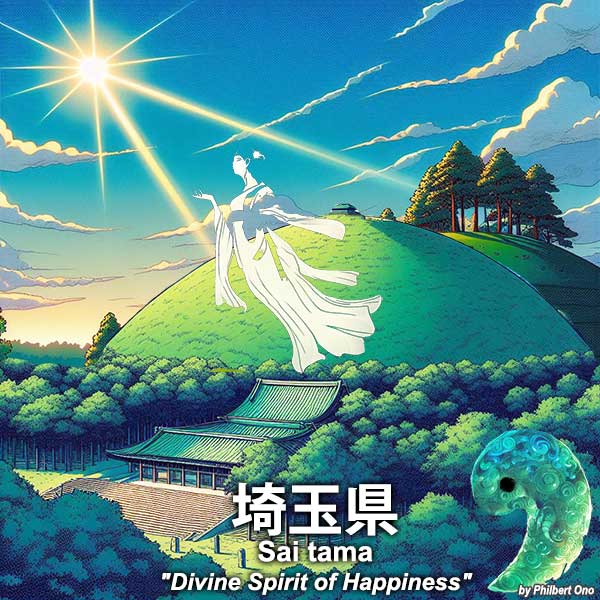SAITAMA – Divine Spirit of Happiness 埼玉県

Although it is basically known where the name “Saitama” came from (a village named “Sakitama” in present-day Gyoda city), the actual meaning remains a mystery. There are multiple theories regarding the meaning, accompanied by multiple ways of writing it in kanji characters (such as 前玉, 佐吉多万, 佐伊太末, 前多摩, 先多摩), each having a different meaning. They were mostly pronounced “Sakitama” before it became “Saitama.”
According to the official website, Saitama Prefecture has decided on 幸魂 (sakitama) as the original kanji characters. It literally means “Happiness Spirit” referring to a god/goddess granting happiness and protection.
They say that tama can also refer to the comma-shaped, magatama (まが玉) ancient jewelry beads worn by ancient Japanese and commonly found in kofun burial mounds. Saitama has these ancient burial mounds in Gyoda city dating back to the 6th century. Gyoda was where Sakitama Village was located. The prefectural crest is a circle of red magatama beads.
The current kanji characters for Saitama (埼玉) are regarded as ateji, chosen for phonetic purposes instead of the meaning. In most cases, ateji kanji usually doesn’t make sense and the meaning remains a mystery. The current kanji characters for “Saitama” literally means “Cape Jewel” which doesn’t make sense.
In the Man’yoshu book of poems dating from the 8th century, “Sakitama” is written as 前玉 or 佐吉多万. In the Wamyō Ruijushō kanji dictionary of Japanese names (和名類聚抄) from the 10th century, the Sakitama district name had morphed into “Saitama” written as 埼玉 or 佐伊太末.
Another theory regarding the meaning says saki means “in front of” and tama means “to accumulate” (tamaru 溜まる), in reference to water since the Sakitama area (now Gyoda) was likely marshland near two rivers.
Another possibility is saki meaning “in front of” in reference to the Saitama area being in front of the Tama area (多摩) in western Tokyo. This is regarded as a long shot theory.
Old province name: Musashi-no-Kuni (武蔵国)
*The AI-generated image is for illustrative purposes only and may not accurately depict any particular place in the prefecture.
*Major reference sources: Official prefectural website, Japanese Wikipedia, other websites.
Origin of other prefectural names (etymologies)
Overview | Aichi | Akita | Aomori | Chiba | Ehime | Fukui | Fukuoka | Fukushima | Gifu | Gunma | Hiroshima | Hokkaido | Hyogo | Ibaraki | Ishikawa | Iwate | Kagawa | Kagoshima | Kanagawa | Kochi | Kumamoto | Kyoto | Mie | Miyagi | Miyazaki | Nagano | Nagasaki | Nara | Niigata | Oita | Okayama | Okinawa | Osaka | Saga | Saitama | Shiga | Shimane | Shizuoka | Tochigi | Tokushima | Tokyo | Tottori | Toyama | Wakayama | Yamagata | Yamaguchi | Yamanashi